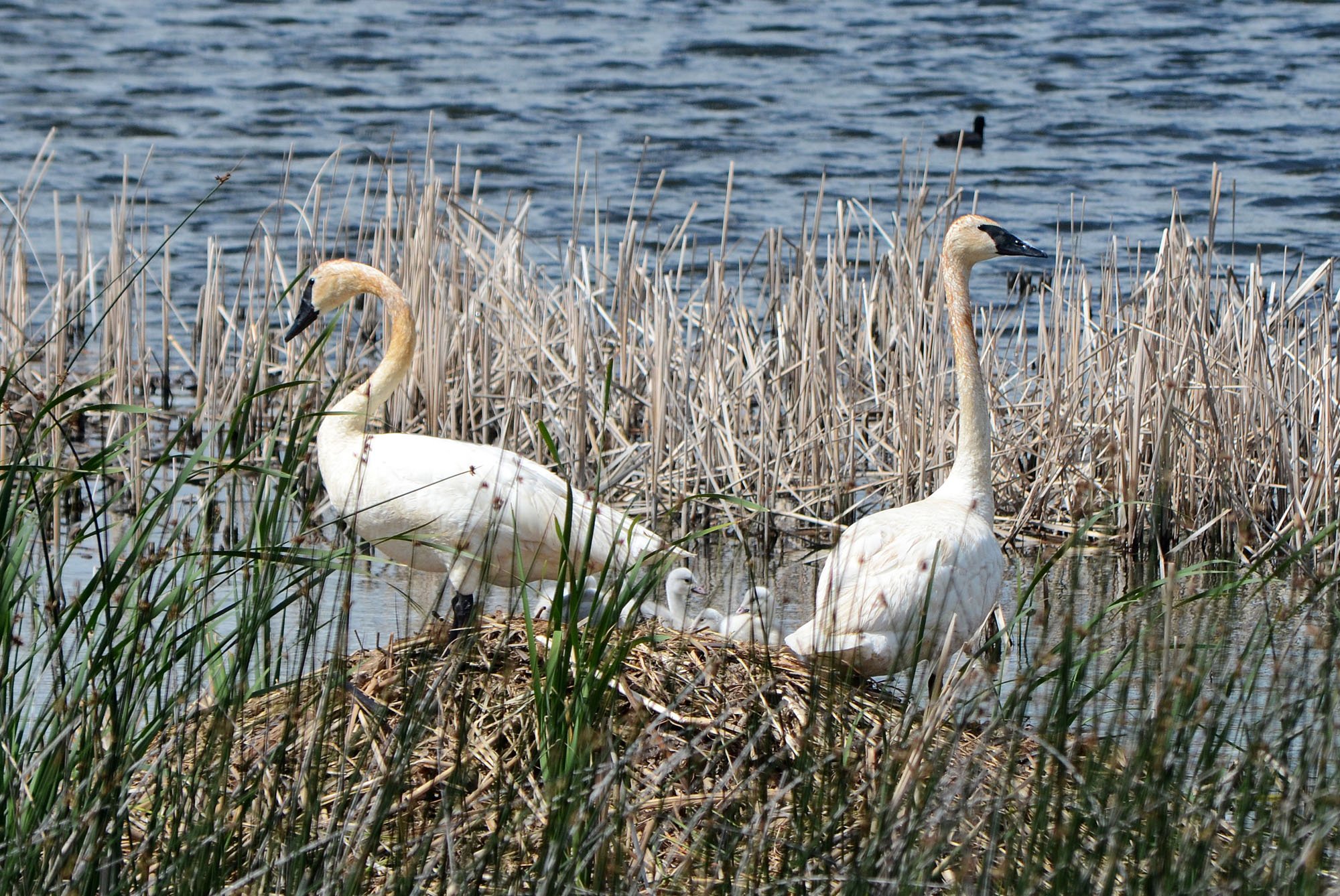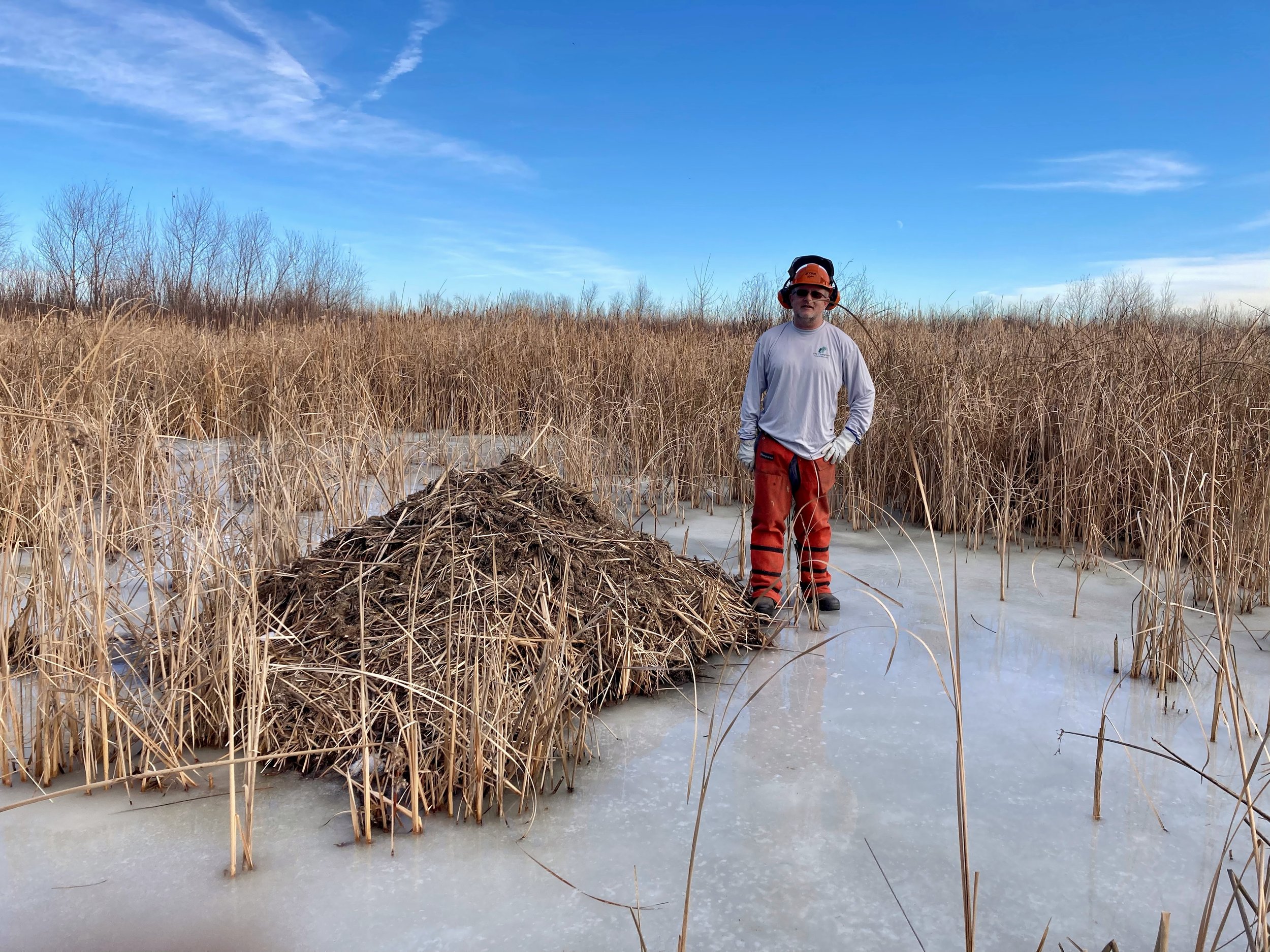December Nature Almanac: Muskrats Cozy up in Winter
By Stephen Jones, with Ruth Carol Cushman and Scott Severs
December 2022
There's a steep embankment along Clear Creek east of Golden where we often see a muskrat perching on a streamside ledge while munching on a leaf or a clump of pond weed. The muskrat seems unperturbed, nibbling away, while we sit on the opposite bank watching. Then, with hardly a sound, she eases into the water and vanishes below the surface.
One of our favorite muskrats munches on a leaf while huddling on the bank of Clear Creek in late November. Photo by Stephen Jones.
An extreme optimist might wait for a half-hour or so for the muskrat to reappear--but to no avail. Her den entrance is located underwater, and she swims unseen from there up to the den floor deep within the embankment.
Besides being warm and cozy, these streamside dens remain inaccessible to most predators, except perhaps mink and snapping turtles. Safe and snug quarters combined with a diet that encompasses virtually anything green enable muskrats to survive Colorado winters on the plains and well up into the mountains.
In the Nebraska Sandhills, muskrat huts provide vital nesting platforms for Trumpeter Swans. Photo by Stephen Jones.
Around lakes and ponds, muskrats construct impressive, beaver lodge-like huts that also have underwater entrances. These huts provide nesting platforms for Trumpeter Swans, the largest waterbirds in North America. The swans lay their eggs right on top, where their newly-hatched young escape being swamped by wave action from violent summer thunderstorms.
While the name muskrat is derived from their potent musk glands, these semi-aquatic rodents are more closely related to voles than to rats or mice. Their tiny ears and blunt snouts are a dead giveaway, as is their habit of crouching on the ground, nibbling away at aquatic plants. They do, however, have virtually waterproof fur, paddle-like feet, and flat-sided tails to help them navigate through the water. The tails help to discriminate muskrats from beavers who have broad flat trails.
The small ears and rounded snouts of muskrats reveal their close relationship to other microtine ("small-eared") rodents, including meadow voles. Photo by Stephen Jones.
At home in virtually every type of river, lake, or pond, muskrats range from the Gulf Coast and Baja California all the way north to Alaska, and a spreading population has become established in Western Europe.
While they store some food in winter, they still need to remain active during the coldest months, feeding primarily on plants growing underwater. When ponds freeze over completely, muskrats chew through the ice with their sharp teeth to create breathing holes. While adults remain mostly solitary outside the spring-summer breeding season, some huddle together in winter to conserve heat.
Pairs begin breeding in early spring and may raise up to three broods each season. A pair may raise 10 or more young in a single year, but up to 90% die from hunting, trapping, predation or diseases. Canine distemper virus, rabies, fungal infections, tularemia, toxic algae, various parasites, and toxic agricultural contamination all have contributed to declining muskrat populations in the Midwest and Northeast.
Warming water temperatures and loss of ephemeral ponds and marshes due to increased evaporation will likely exacerbate these trends over time. Because of their wide distribution and adaptability, muskrats have not yet appeared on most regional or national species of concern lists. But biologists are beginning to use them as a bellwether of degradation and loss of wetlands throughout North America.
Construction of the largest huts can enrich diversity in the marsh, creating areas of open water for foraging herons, ducks, and fish. Photo by Scott Severs.
Other December Events
The Boulder Christmas Bird Count occurs on Sunday, December 18. Beginners are always welcome. To learn more and register, visit the event page. The Longmont count occurs on Saturday, December 17.
Common Loons were seen on Baseline Reservoir, and tundra swans on Boulder and Valmont reservoirs in November, and some may linger through early December.
Listen for cheeping and twittering Bushtits in shrubby areas in towns and in the foothills. Their recent population explosion within Boulder County may be related to the spread of shrubbery throughout urban areas and removal of grazing cattle from natural shrublands in the foothills.
Early Easter daisies have already begun blooming on shale slopes in Bear Canyon, in the Boulder Mountain Park.
An early Easter daisy with a bee. Photo by Stephen Jones.





